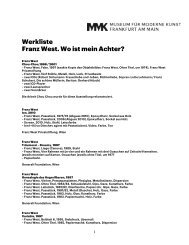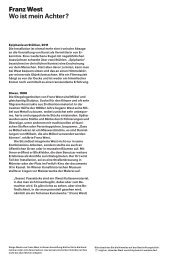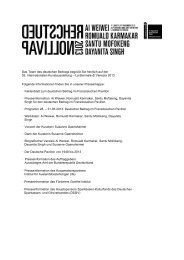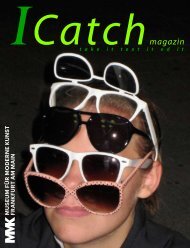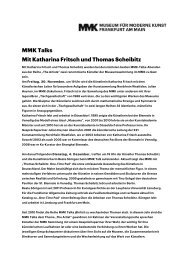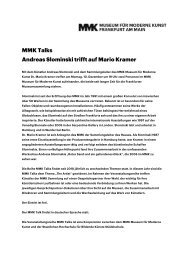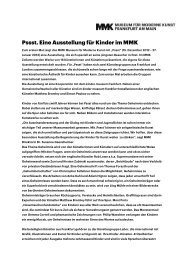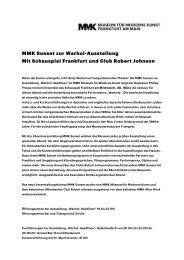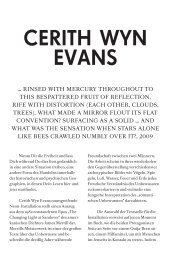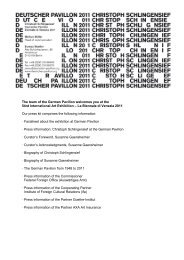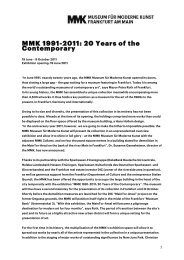Andy Warhol - Museum für Moderne Kunst
Andy Warhol - Museum für Moderne Kunst
Andy Warhol - Museum für Moderne Kunst
Erfolgreiche ePaper selbst erstellen
Machen Sie aus Ihren PDF Publikationen ein blätterbares Flipbook mit unserer einzigartigen Google optimierten e-Paper Software.
<strong>Andy</strong> <strong>Warhol</strong><br />
Multiplied Jackies, 1964<br />
„Thirty-five are better than one“<br />
„Bei den Porträts von Jacqueline Kennedy in der<br />
Todes-Serie ging es mir nur darum, ihr Gesicht<br />
und den Ablauf der Zeit von dem Augenblick, als<br />
die Kugel John Kennedy traf, bis zu dem Augenblick<br />
als sie ihn begruben, zu zeigen – oder so etwas<br />
ähnliches. In den Vereinigten Staaten herrscht<br />
der herrliche Brauch, aus allem und jedem einen<br />
Helden zu machen. Man könnte hier alles tun.<br />
Oder auch gar nichts.“ (Nichts zu verlieren, <strong>Andy</strong><br />
<strong>Warhol</strong> in einem Gespräch mit Gretchen Berg,<br />
in: <strong>Andy</strong> <strong>Warhol</strong> und seine Filme, hg. von Enno<br />
Patalas, S. 18)<br />
Bereits 1964 reihte <strong>Andy</strong> <strong>Warhol</strong> Jacqueline Kennedy<br />
(Red Jackie, 1964) in die Serie seiner stilisiert<br />
anmutenden Porträts der Filmikonen Marilyn<br />
Monroe und Liz Taylor ein. An dieses berühmte<br />
Einzelporträt anschließend schuf er etliche verschiedene<br />
Versionen von Jackie-Bildern. Allesamt<br />
sind diese aus Pressefotografien entstanden, die<br />
kurz vor bzw. nach der Ermordung Kennedys aufgenommen<br />
wurden – die Bandbreite reicht von der<br />
lachenden Jackie mit Pillbox kurz vor dem Attentat<br />
in Dallas, über Bilder während der Vereidigung<br />
Johnsons, bis hin zu jenen der Beerdigung Kennedys.<br />
Letztere muten mit Schleier vor dem Gesicht<br />
wie ein Madonnenbildnis an. Sämtliche Bildvorlagen<br />
entstammen den Massenmedien und wurden<br />
bereits tausendfach reproduziert. <strong>Warhol</strong> wiederholt<br />
ein Motiv in Serien oder mischt verschiedene<br />
Motive – z. T. auch gekontert – wie in einem<br />
Memoryspiel in unterschiedlichsten Reihungen.<br />
Trotzdem umgibt er jene „Massenbilder“ mit der<br />
Aura des „Originals“. Auffällig oft sind die Jackie-<br />
Bilder in Siebdruck auf blau oder weiß grundierte<br />
Leinwand gedruckt. Es existieren allerdings auch<br />
einzelne Jackies, Madonnenikonen vergleichbar,<br />
auf Goldgrund gedruckt, wie die Gold Marilyn<br />
von 1962.<br />
Für die Multiplied Jackies (1964) aus der Sammlung<br />
des <strong>Museum</strong>s <strong>für</strong> <strong>Moderne</strong> <strong>Kunst</strong> reproduziert<br />
<strong>Andy</strong> <strong>Warhol</strong> (1928-1987) das Profilbildnis von<br />
Jacqueline Kennedy auf 35 Einzeltafeln (je 51 x<br />
40,5 cm), die er zu einem großen Bild zusammensetzt.<br />
Die Farbigkeit der Darstellung reduziert er<br />
auf zwei Farben. Im Siebdruckverfahren wird das<br />
Bildnis der Jackie in schwarzer Farbe auf die blau<br />
“Thirty-five are better than one”<br />
“In the Flint heads I did of Jacqueline Kennedy in<br />
the death series, it was just to show her face and<br />
the passage of time from the time the bullet struck<br />
John Kennedy to the time she buried him. Or<br />
something. The United States has a habit of<br />
making heroes out of anything and anybody,<br />
which is so great. You could do anything here.<br />
Or do nothing.” (Nothing to Lose, Interview with<br />
<strong>Andy</strong> <strong>Warhol</strong> by Gretchen Berg, Cahiers du Cinema<br />
in English, No. 10, May 1967, p. 42)<br />
As early as 1964, <strong>Andy</strong> <strong>Warhol</strong> included Jacqueline<br />
Kennedy (Red Jackie, 1964) in the series of<br />
essentially stylized portraits he had made of movie<br />
icons Marilyn Monroe and Liz Taylor. He was to<br />
add many different versions of “Jackie” pictures to<br />
this famous single portrait. All of them were based<br />
on press photos taken shortly before or in the<br />
aftermath of John F. Kennedy’s assassination –<br />
and range from a laughing Jackie in a pillbox hat<br />
just before the assassination in Dallas via pictures<br />
during Johnson’s swearing-in ceremony through to<br />
her husband’s funeral. The latter photos depicting<br />
her with a veil over her face call to mind a picture<br />
of the Madonna. Not only did all the models for his<br />
photos stem from the mass media, they had already<br />
been reproduced thousands of times. <strong>Warhol</strong><br />
repeats a subject in series or mixes different subjects<br />
– sometimes juxtaposing the topics by lining<br />
them up like the cards in a game of Memory.<br />
Nevertheless, he surrounds these mass-produced<br />
pictures with the aura of the “original”. Conspicuously<br />
often, the Jackie pictures are printed using<br />
the silk-screen technique on canvases with a blue<br />
or white background. However, there also exist<br />
some individual Jackies printed on a golden background<br />
– in the manner of Madonna icons –<br />
mimicking the Gold Marilyn of 1962.<br />
For the Multiplied Jackies (1964) in the <strong>Museum</strong><br />
<strong>für</strong> <strong>Moderne</strong> <strong>Kunst</strong> Collection, <strong>Andy</strong> <strong>Warhol</strong><br />
(1928-1987) reproduced Jacqueline Kennedy’s<br />
portrait in profile on 35 individual panels each<br />
measuring 51 x 40.5 cm, which are combined to<br />
form one single large picture. He uses the silkscreen<br />
method to reduce the color to just two<br />
tones: Jackie’s image in black is transferred to<br />
a canvas primed in blue. We are struck by the
grundierte Leinwand übertragen. Auffällig sind<br />
die unterschiedlichen Nuancen der schwarzen Farbe,<br />
was davon abhängt wie sorgfältig das Seidensieb<br />
nach dem jeweiligen Druckvorgang gereinigt<br />
wurde. Insgesamt vermittelt der blaue Hintergrund<br />
einerseits eine strahlend leuchtende Farbigkeit und<br />
andererseits auch eine starke emotionale Kälte.<br />
<strong>Warhol</strong> benutzte als Vorlage zu dieser Arbeit einen<br />
Zeitungsausschnitt, der Jacqueline Kennedy am<br />
22. November 1963, nur wenige Stunden nach<br />
dem tödlichen Attentat auf ihren Mann John F.<br />
Kennedy zeigt, während sie der Vereidigung seines<br />
Nachfolgers als US-Präsident Lyndon B. Johnson<br />
an Bord der Air Force One beiwohnt. Jackie trägt<br />
noch immer jenes Kostüm, das sie bei der Wahlkampftour<br />
durch Dallas an der Seite ihres Mannes<br />
getragen hatte. Ihren Hut – die legendäre Pillbox –<br />
hat sie abgelegt. Mit leicht gesenktem Blick nimmt<br />
sie wie abwesend an der Zeremonie teil. Indem<br />
<strong>Andy</strong> <strong>Warhol</strong> den Bildausschnitt <strong>für</strong> seinen Siebdruck<br />
einerseits beschneidet und gleichzeitig vergrößert,<br />
wird das Gesicht von Jackie im Profil auf<br />
wesentliche Merkmale reduziert. Interessanterweise<br />
gibt es bereits 1962, ein Jahr vor dem Attentat,<br />
eine Zeichnung <strong>Warhol</strong>s Profile of a Woman –<br />
wahrscheinlich ein werbegrafischer Entwurf – der<br />
das Gesicht in verblüffender Ähnlichkeit ebenfalls<br />
auf blauem Grund, im Profil und mit gesenktem<br />
Blick wiedergibt. Jackies dunkles, volles, zur Seite<br />
gescheiteltes Haar verdeckt die Augenpartie, bis<br />
auf die Andeutung der Brauen und des linken<br />
Auges, nahezu vollständig und gibt den Blick<br />
lediglich auf Nase, leicht geöffnete Lippen, Kinnpartie<br />
und einen Halsausschnitt frei. Der Kragen<br />
des Kostüms wird angedeutet. Diese Darstellungsweise<br />
führt zu einer starken Abstraktion des Bildmotivs.<br />
Betrachtet man die Bildtafel aus der Ferne,<br />
ergibt sich der Eindruck eines repetitiven abstrakten<br />
Ornaments.<br />
<strong>Andy</strong> <strong>Warhol</strong> hat jeweils sieben Einzeltafeln in<br />
fünf Riegeln zusammengefügt, so dass eine große<br />
Bildfläche von 255,5 x 283,5 cm entsteht. Durch<br />
die Auswahl und Zusammenstellung der verschieden<br />
nuancierten Jackies entsteht ein Rhythmus, der<br />
eine Spannung beim Betrachten erzeugt. Jene Bildpartien<br />
des Gesichtes von Jackie, die unbedruckt<br />
blieben, zeigen die glatte, blaue Grundierung der<br />
Leinwand und werden durch die rhythmischen<br />
Strukturen des schwarzen Siebdrucks akzentuiert.<br />
Auch die hellen Kanten des Siebdruckrahmens an<br />
einzelnen Bildober- und -unterkanten unterstreichen<br />
die Bildrhythmik. Die vielfältigen Erscheinungsweisen<br />
der Einzeltafeln sind von <strong>Warhol</strong><br />
kalkuliert. So wird der Betrachter von ihm auf eine<br />
Entdeckungsreise geschickt, die ein und dasselbe<br />
Bildmotiv in fünfunddreißigfacher Wiederholung<br />
nicht langweilig erscheinen lässt. Ist man einer-<br />
varying shades of the black color, the latter determined<br />
by how much care is used to clean the silkscreen<br />
after each print. Generally, the blue background<br />
conveys both a bright, brilliant colorfulness<br />
but also an intense emotional coldness. <strong>Warhol</strong><br />
modeled his work on a newspaper clipping, which<br />
depicts Jacqueline Kennedy on November 22, 1963<br />
– just a few hours after the assassination of her<br />
husband John F. Kennedy, at the swearing-in ceremony<br />
for Lyndon B. Johnson his successor as<br />
U.S. President – on board Air Force One. Jackie<br />
is still wearing the suit she wore to accompany her<br />
husband on his election tour through Dallas. She<br />
has removed her trademark pillbox hat, her gaze<br />
is lowered, and there is a faraway look about her.<br />
By selecting a smaller section of the picture and<br />
enlarging it <strong>Andy</strong> <strong>Warhol</strong> reduces Jackie’s face in<br />
profile to its essential characteristics. Interestingly,<br />
as early as 1962, one year before the assassination<br />
<strong>Warhol</strong> produced a drawing called Profile of a<br />
Woman – probably a design for a commercial project<br />
– which is remarkably similar: it features a<br />
face likewise on a blue background, in profile, and<br />
with lowered gaze. Jackie’s dark, abundant hair,<br />
parted at the side almost completely covers her<br />
eyes, so that there is only a hint of the brows and<br />
the left eye, whereas the nose, slightly parted lips,<br />
chin and part of the neck are revealed and the<br />
collar of her suit is hinted at. This method of depiction<br />
creates a strong abstract effect. Looking at<br />
the picture from a distance creates the impression<br />
of a repetitive abstract ornament.<br />
<strong>Andy</strong> <strong>Warhol</strong> arranged the individual panels in<br />
five rows of seven thereby producing a large pictorial<br />
surface of 255.5 x 283.5 cm. His selection and<br />
arrangement of the different Jackie versions gives<br />
rise to a rhythm, to tension in the observer. Those<br />
sections of Jackie’s face that remain unprinted,<br />
reveal the smooth, blue primer on the canvas, and<br />
are emphasized through the rhythmic structures of<br />
the black silk-screen techniques. Moreover, the<br />
light upper or lower edges of the silk-screen frame<br />
underscore the picture rhythm. The various different<br />
appearances of the individual panels was a<br />
deliberate device by <strong>Warhol</strong>. In effect, he sends the<br />
observer on a journey of discovery in which the<br />
self-same subject repeated 35 times never appears<br />
boring. Despite being full of sympathy for this<br />
young woman, and her tragic fate, despite admiring<br />
her resilience in such a moment, the serial<br />
repetition of the image simultaneously has the<br />
effect of making the “suffering” appear more<br />
abstract. The series of different images are reminiscent<br />
of strips of negatives, rolls of film or the<br />
TV screens in our hi-fi departments, and thus<br />
replicate an information overload by the media.<br />
Moreover, the observer can also run through the
seits voll Mitleid <strong>für</strong> diese junge Frau sowie ihr<br />
tragisches Schicksal und bewundert ihre Stärke in<br />
solch einem Moment, so scheint die serielle Wiederholung<br />
des Bildmotivs gleichzeitig auch das<br />
„Leid“ zu abstrahieren. Die Serien des Bildmotivs<br />
erinnern an Negativstreifen, Filmrollen oder die<br />
Fernsehwände in unseren Hi-Fi-Abteilungen und<br />
damit an eine mediale Reizüberflutung. Auch das<br />
Jackie-Bild kann der Betrachter mit seinen Augen –<br />
Bild <strong>für</strong> Bild, Reihe <strong>für</strong> Reihe – wie einen Film abfahren.<br />
So sehr uns das Motiv bewegt, so sehr mildert<br />
das Serielle die Brisanz des Inhalts ab. Scheint<br />
uns doch ein Einzelbild die Tragik und Gemütsregung<br />
eines Augenblicks viel direkter zu vermitteln,<br />
als die Wiederholung eines Images. <strong>Warhol</strong> sagte<br />
selbst zur Themenwahl: „Die Welt fasziniert mich,<br />
sie ist schön, was immer sie sonst noch sein mag.<br />
Ich bin einverstanden mit allem, was die Leute<br />
tun; da irgendjemand gesagt hat, es sei richtig,<br />
muss es schon richtig sein. Ich würde über niemanden<br />
ein Urteil fällen. Ich fand Kennedy großartig,<br />
aber sein Tod schockierte mich nicht; er<br />
ereignete sich, das war alles. Es ist nicht meine<br />
Sache, darüber ein Urteil abzugeben. Ich hatte<br />
vor, einen Film über die Ermordung zu machen,<br />
aber ich hab’s nie getan. Ich bin außerordentlich<br />
passiv. Ich nehme die Dinge hin, wie sie sind.<br />
Ich schaue bloß zu, ich beobachte die Welt.“<br />
(Nichts zu verlieren, <strong>Andy</strong> <strong>Warhol</strong> in einem<br />
Gespräch mit Gretchen Berg, S. 17)<br />
<strong>Andy</strong> <strong>Warhol</strong> hat seine Umgebung intensiv beobachtet<br />
und in seinen <strong>Kunst</strong>werken unmittelbar<br />
darauf reagiert. Neben den Jackies gab es Vervielfältigungen<br />
Elvis Presleys, Marilyn Monroes, Liz<br />
Taylors oder der Mona Lisa. Schnell wird klar,<br />
dass <strong>Warhol</strong> in seiner Themenwahl auch Anleihe<br />
bei anderen Künstlern nahm. Im Dezember 1962<br />
wurde Leonardo da Vincis Mona Lisa zuerst in der<br />
National Gallery of Art in Washington D. C. und<br />
anschließend im Metropolitan <strong>Museum</strong> of Art in<br />
New York ausgestellt. Die Persiflage auf Mona Lisa<br />
L.H.O.O.Q (1919) von Marcel Duchamp konnte<br />
<strong>Andy</strong> <strong>Warhol</strong> nachweislich 1963 bei der großen<br />
Retrospektive Duchamps im Pasadena Art <strong>Museum</strong><br />
betrachten. <strong>Warhol</strong>s dreißigfache Vervielfältigung<br />
von Leonardo da Vincis Mona Lisa – Thirty Are<br />
Better Than One (1963) lässt sich als Grundprinzip<br />
auch auf die Jackies übertragen.<br />
<strong>Warhol</strong> thematisiert das „Image Jackie“, die als<br />
Präsidentengattin in Amerika zum Massenartikel<br />
wurde. Handelt es sich bei den Bildern Jackies<br />
doch um ein historisches Dokument über den Exhibitionismus<br />
der Gefühlswerte dieser Frau, deren<br />
Emotionen zum Objekt wurden. „Die Idee Amerikas<br />
ist wunderbar – je gleicher etwas ist, desto amerikanischer<br />
ist es auch.“ (Die Philosophie des <strong>Andy</strong><br />
Jackie picture – image for image, row for row like<br />
a film. Although we are very moved by the subject,<br />
its serial presentation softens the explosiveness of<br />
the content. It would seem as if a single picture is<br />
much more capable of conveying the tragedy and<br />
emotion of a moment, than the repetition of an<br />
image. <strong>Warhol</strong> said the following on his choice<br />
of subject: The world fascinates me. It’s so nice,<br />
whatever it is. I approve of what everybody does:<br />
it must be right because somebody said it was<br />
right. I wouldn’t judge anybody. I thought Kennedy<br />
was great, but I wasn’t shocked at his death: it was<br />
just something that happened. It isn’t for me to<br />
judge it. I was going to make a film on the assassination<br />
but I never did. I’m very passive. I accept<br />
things. I’m just watching, observing the world.<br />
(Nothing to Lose, Interview with <strong>Andy</strong> <strong>Warhol</strong> by<br />
Gretchen Berg, Cahiers du Cinema in English, No.<br />
10, May 1967, p. 42)<br />
<strong>Andy</strong> <strong>Warhol</strong> was a very intense observer of his<br />
environment, and in his works of art he responded<br />
directly to what he saw. Alongside the Jackies<br />
there are also multiple pictures of Elvis Presley,<br />
Marilyn Monroe, Liz Taylor and the Mona Lisa. It<br />
becomes quickly clear that <strong>Warhol</strong> also borrowed<br />
from other artists in choosing his subjects. In<br />
December 1962, Leonardo da Vinci’s Mona Lisa<br />
was first shown in the National Gallery of Art, in<br />
Washington D. C. before being displayed in the<br />
Metropolitan <strong>Museum</strong> in New York. It is known<br />
that <strong>Andy</strong> <strong>Warhol</strong> saw the Marcel Duchamp satire<br />
of Mona Lisa L.H.O.O.Q (1919) in 1963 during the<br />
great Duchamp retrospective in the Pasadena Art<br />
<strong>Museum</strong>. <strong>Warhol</strong>’s thirty-fold reproduction of<br />
Leonardo da Vinci’s Mona Lisa - Thirty Are Better<br />
Than One (1963), follows a basic principle also<br />
applied to the Multiplied Jackies.<br />
<strong>Warhol</strong> explores the image of a woman, whose<br />
position as the President’s wife meant she was<br />
treated like some mass-produced article. In effect,<br />
the multiplied Jackies represent a historical document<br />
on how her emotional values were publicly<br />
exhibited, how her emotions became an object.<br />
The idea of America is so wonderful because the<br />
more equal something is, the more American it is.<br />
(The Philosophy of <strong>Andy</strong> <strong>Warhol</strong>, p. 101) <strong>Warhol</strong>’s<br />
repetition reinforces the impression that we are<br />
dealing with an object: Thirty-five are better than<br />
one. This principle still holds true for our present<br />
day.<br />
Marcella Sohmen<br />
Translation: Jeremy Gaines, Frankfurt am Main
<strong>Warhol</strong> von A bis B und zurück, S. 106) <strong>Warhol</strong>s<br />
Repetition verstärkt den Eindruck des Objekthaften:<br />
Thirty-five are better than one. Dieses Prinzip lässt<br />
sich bis in unsere Zeit übertragen.<br />
Marcella Sohmen<br />
Multiplied Jackies, 1964<br />
Acryl auf Liquitex im Siebdruckverfahren auf Leinwand<br />
Acrylic on liquitex, silk-screen technique on canvas<br />
35 Tafeln je 51 x 40,5 cm, 255,5 x 286,5 cm<br />
35 panels measuring 51 x 40.5 cm, 255.5 x 286.5 cm<br />
<strong>Museum</strong> <strong>für</strong> <strong>Moderne</strong> <strong>Kunst</strong>, Frankfurt am Main<br />
Ehemalige Sammlung Karl Ströher, Darmstadt<br />
Former Karl Ströher Collection, Darmstadt<br />
(Inv. 1981/58)<br />
<strong>Museum</strong> <strong>für</strong> <strong>Moderne</strong> <strong>Kunst</strong><br />
Frankfurt am Main<br />
1003



